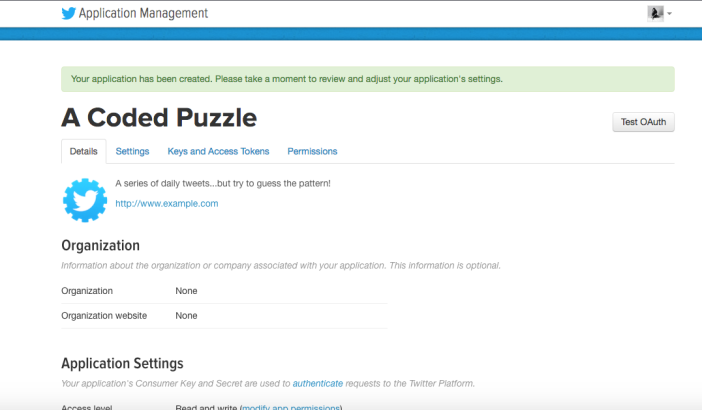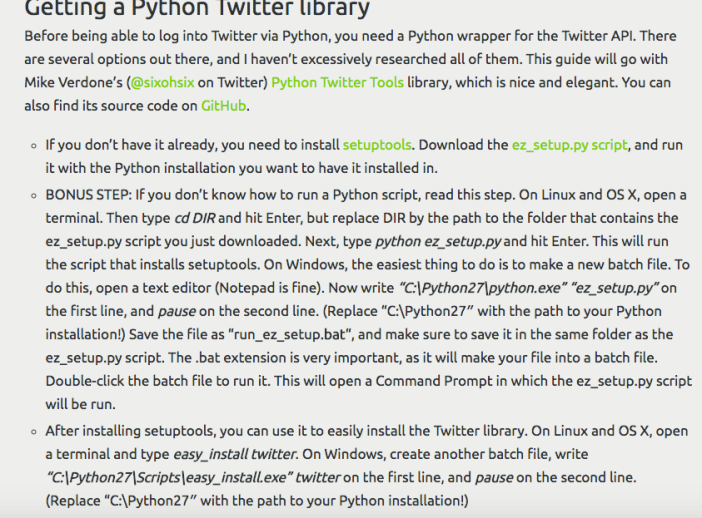I’m proud to state that progress has been made for my Twitter bot! This week, after our seminar, I wanted to focus on diving into the programs and investigating how each are linked to end up creating the finished product. Google has (obviously) become my best friend at this point, as I’ve been searching up the precise instructions and code sequences to enter into Python. I stated in my previous entry that “you can make computers do wonderful things, but you need to understand their limits,” (Ford 2015). These words were represented very well this week, as I hit a major roadblock in my coding journey. According to the instructions for creating a simple Twitter Bot, I successfully created a Twitter account, easily created a Twitter app and copied my Consumer Key, Consumer Secret, Access Token and Access Token Secret to my notes.

I hit my roadblock when I read that I had to download ‘setuptools’ for Python, and run it with the Python installation I already have. At first, I thought I had ‘setuptools’ already, so I searched on Terminal if it was anywhere on my computer. Conveniently not remembering how to navigate Terminal, I used the DSMCode website to help me remember my special letters to use.

Turns out, I don’t have ‘setuptools’. I ended up downloading a zip file that apparently had ‘setuptools’ and other helpful documents to aid me with my Twitter Bot installation, but neither of them worked nor made any sense to me. I can see my completed Twitter Bot as being a wonderful accomplishment that my computer was able to do; however, I’m experiencing the computer’s limits right now.
It’s interesting to see how the attitudes of technology, especially code, have changed over time. 20 years ago, the word ‘code’ in our heads would correspond with companies like Microsoft, Norton and Apple; whereas today, the word ‘code’ resonates with a variety of specific technologies: social media, computer science, app production, the list goes on. Historically, it was discussed that“ the number of people with some variety of online access increased from month to month; therefore, more and more people had an experience of stumbling upon something striking,” (Streeter 2005, p. 756). The many ‘striking’ revelations essentially led the change of thinking with computers and society. People were discovering the endless opportunities within the internet as well as the variety of functions computers (at their respective time) could perform. Computers and society eventually became a structure of “modern autonomous imaginative hedonism”, in which “the anticipation of pleasure becomes part of the pleasure itself,” (Streeter 2005, p. 759). Again, I’m relating back to Ford with the idea that one can make wonderful things happen with the computer. This structured way of thinking is what society today has, in that we feed our anticipation with technology by actively discovering new forms of it, specifically, code. Keeping this attitude change with technology in mind, I’ve chosen to nurture my curiosity with code by experiencing it firsthand, and developing my code literacy through the many roadblocks and accomplishments I have and will encounter.
REFERENCES:
Ford, Paul 2015, What Is Code?, Brooklyn, viewed 2 September 2017,
<https://www.bloomberg.com/graphics/2015-paul-ford-what-is-code/>.
PyGaze 2016, Tutorial: Creating A Twitter Bot, United Kingdom, viewed 11 September 2017, <https://www.pygaze.org/2016/03/how-to-code-twitter-bot/>.
Streeter, T. 2005, ‘The Moment of Wired’, Critical Inquiry, vol. 31, no. 4, pp. 755-779.